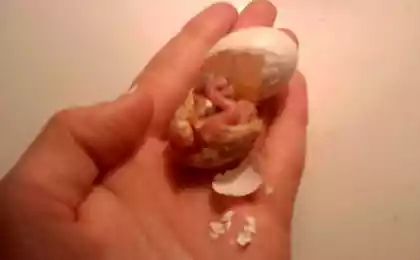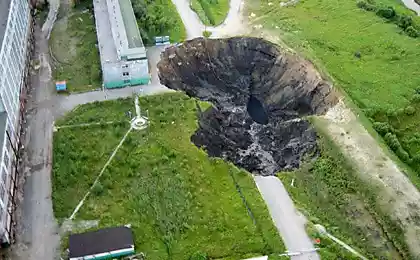945
Photo: "Uralkali"
The journey begins. At a depth of over 400 meters from the mine shaft directly to the workings of miners delivers "mole." This is a 24-seater vehicle designed and constructed in Nizhny Novgorod "Tehnoservis" based on the shortened chassis of the bus PAZ-3205. The engine - a four-aspirated diesel Toyota-5L. The other parts of the domestic cars. The mine operates a speed limit of 20 km / h and only by special permission - 40 km / h.

Sami potash mine - insanely beautiful. And it's a great business. In the world there are at least a dozen significant potash producers. Due to the extremely small number of fields throughout the world and even less - rich - the industry has developed a real oligopoly. Moreover, the five market leaders operate through two traders: Canadian Canpotex (representing the interests of Potash Corp., Mosaic and Agrium) and Belarusian Potash Company ("Belaruskali" and "Uralkali"). And this couple, which accounts for almost two-thirds of world exports of potassium, can suit almost limitless dictates prices.
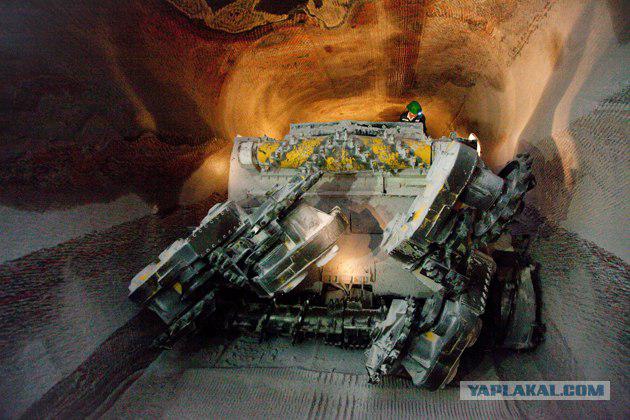
The ore is extracted by means of special rotary combines. Now "Uralkali" is technical re: he was the first in the former Soviet Union signed an agreement with an international company Sandvik Mining & Construction. Testing rotary combine Marietta 900 showed that its performance exceeds 10 tonnes of potash per minute. Domestic machines give no more than 7 tons.
It is here that formed the basis for the multi-billion dollar capitalization of "BRIC" (more than $ 26 billion). Costs of production of a ton of potassium chloride are constant and do not exceed $ 100. A spot price for it, for example, in the markets of Southeast Asia have recently reached $ 535 per ton on the terms of delivery to the port of the buyer. Can you imagine what should be the profitability of this business? Since 2006, the margin of the "BRIC" EBITDA margin does not fall below 50%. A net profit margin in 2010 was 41%. Cellular companies and miners earn less natural gas. Now I think you are a bit different eyes looking at the work of the rotary combine.

Before descending into the mine every employee is given a helmet with a flashlight and a filter self-rescuer (individual respiratory protection) for use in emergency situations. Fortunately, they are extremely rare.
Last accident dates from the beginning of 2010, when a miner was killed because of a gas explosion in one of the faces. Then this news shares of the company dropped by 3%. A major accident occurred in 2006 at the old mine company BKRU-1. Because of the peculiarities of the geological structure of the mine field in development spewed brine, which led to a sharp increase in the level of hydrogen sulfide in the air. To overcome the consequences of the release and failed, and the management decided to flood the mine.
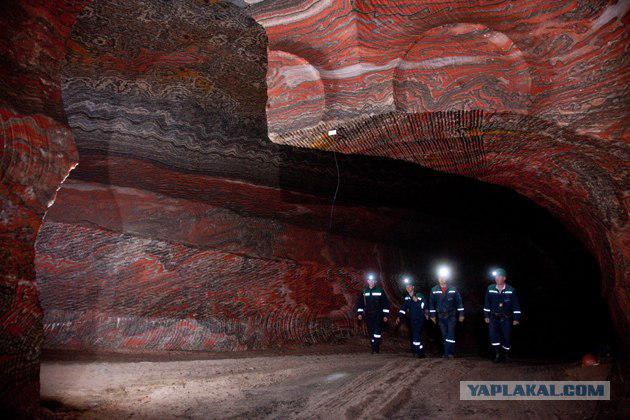
Flooding BKRU-1 resulted in a failure on the surface. "Uralkali" for a long time to disentangle the effects of the disaster. Although it started bad for the company: in late 2006, a special commission of Rostekhnadzor decided that technogenic accident occurred due to reasons beyond the control of the "BRIC." However, in October 2008 at a meeting with Deputy Prime Minister Igor Sechin, it was decided to establish a new Commission and the resumption of the investigation of the case. In 2009, "Uralkali" has paid compensation in the amount of 7, 8 bln. Two-thirds of the amount went to the construction of railway line bypassing all areas Verkhnekamskoye potash deposit.

2006 in general was not very successful for the company. Before the flooding of the mine, which accounts for a significant part of production, "Uralkali" attempted IPO. For the London Stock Exchange then owner Dmitry Rybolovlev praised his business at least $ 4, 3 billion. But even at this price, investors disagreed.

The extracted ore is placed in an underground warehouse. Stocks sylvinite (a raw material for the production of potassium chloride), belonging to the "BRIC", account for 22% of the world. In absolute terms, stocks occurring salts are 4, 27 billion tonnes, which at current production levels, the company can provide the raw material for 200 years.
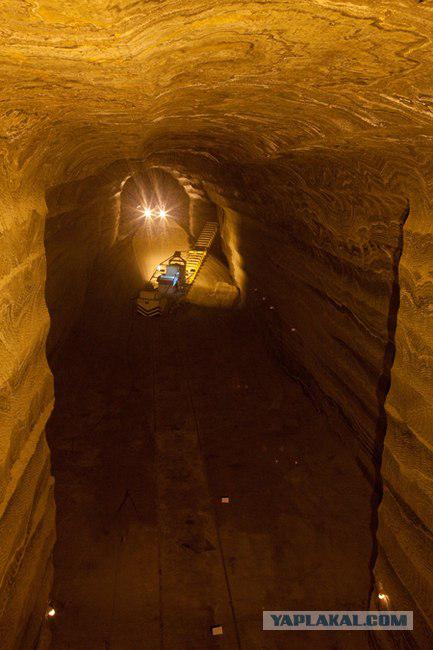
On the underground storage of ore running scraper conveyor (Krazer-tap). This device is a continuous, wherein the potash ore moves along the stationary trough-pans using scrapers.

This is a terrifying roar, and the place is always filled with dust. By the way, it is useful for light, but cause irritation and even skin ulcers. Including so (under the ground still cool) miners dressed in several layers of uniform, tight to the body at the wrists and throat, and after a change is required to take a shower.

It has become quieter, you can talk further. In 2010, "Uralkali" changed hands. Dmitry Rybolovlev, the last with the company in the second half of 90th and zero, sold it to a group of investors. As a result, control of the company received Suleiman Kerimov.

The red layer - potassium, gray - clay, white - table salt. Intricate patterns left Perm sea lapped here many years ago.
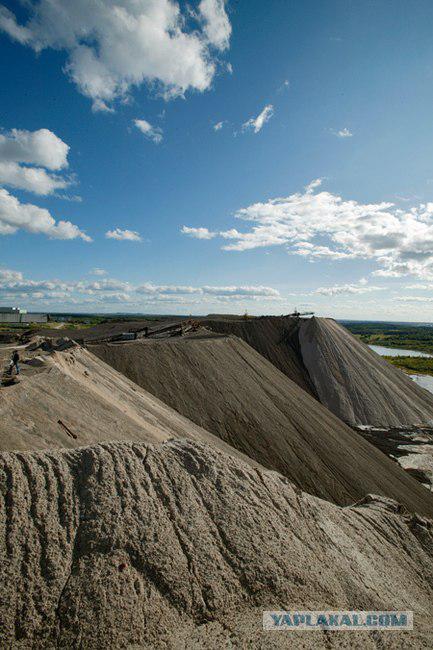
Now the factory. Skip hoists Siemag at once raises up to 30 tonnes of potash ore from the 400-meter depth. Main components: track, skips (vessels), lifting machine, pile driver, the traction rope ferries in their careers and on the surface. Just last item - the photograph.

The department crushing potash ore flotation plant with the help of a rod mill and sieve is brought to the size required for further enrichment process.
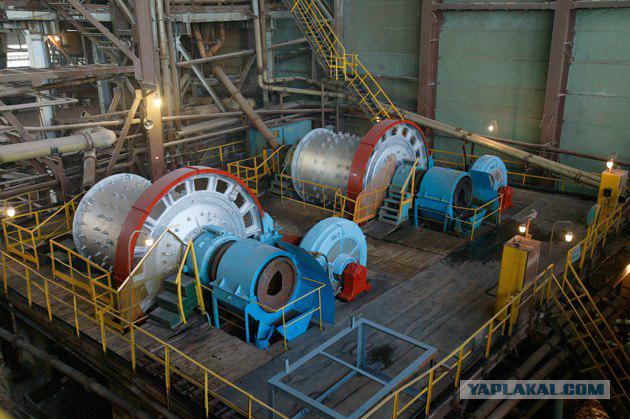
End of the raw ore is obtained by two main methods. The first - hot-leaching method used since the birth of the potash industry in the second half of the XIX century. It is based on the change of joint solubility of potassium chloride (KCl) and sodium chloride (NaCl) in water at different temperatures. Fragmented sylvinite ore is dissolved in the hot liquor in solvents with screw mixers and bucket elevators, then cooled in ponds. Thus a saturated solution of KCl crystallizes. The content of useful component in the obtained raw material reaches 98%, it can be used not only in agriculture but also in the chemical industry.

The flotation method has been used since the 1960s. It got its name due to the fact that it is based on various flotation (vsplyvaemosti) minerals sylvite and halite. Partially purified ore is placed in a flotation machine, the bubbles adhere to the particles of potassium chloride and push them onto the surface of the mixture for the subsequent separation. Then it is condensed, filtered, dried and pelletized. After drying, the humidity of pink MOP with nutrient content of 95% is only 0, 1%.

And we got a very valuable addition to the soil. Valuable - in the truest sense of the word. Price of potash has grown since the crisis, but has not yet reached the highs of 2008 ($ 650 per ton).
It's simple: phosphorus and nitrogen supplements work to increase the volume. A potash fertilizers to improve plant quality. However, they do not accumulate in the soil, so that the farmer is required to make all new portions. Given the continued growth of the population (in the world already live 7 billion people) and improve the quality of life in the Third World (the population wants to eat better) perspective of "BRIC" seem rosy.
But the proposal will grow. Market leader - Canadian Potash Corp. - By 2013, expand its capacity in half. American Mosaic also pays close attention to new projects in the plans - by 2020 to increase the capacity of 5, 1 million tons. That's a lot: the extraction of the "BRIC" (taking into account assets "Silvinit") for the first 9 months of 2011 amounted to 8, 06 million tons.
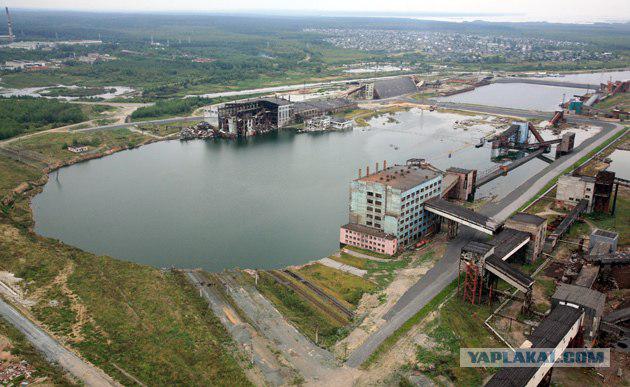
Blades potash mine in Berezniki: decades of production are poured heaps of empty ore.
All!

Source:

Sami potash mine - insanely beautiful. And it's a great business. In the world there are at least a dozen significant potash producers. Due to the extremely small number of fields throughout the world and even less - rich - the industry has developed a real oligopoly. Moreover, the five market leaders operate through two traders: Canadian Canpotex (representing the interests of Potash Corp., Mosaic and Agrium) and Belarusian Potash Company ("Belaruskali" and "Uralkali"). And this couple, which accounts for almost two-thirds of world exports of potassium, can suit almost limitless dictates prices.

The ore is extracted by means of special rotary combines. Now "Uralkali" is technical re: he was the first in the former Soviet Union signed an agreement with an international company Sandvik Mining & Construction. Testing rotary combine Marietta 900 showed that its performance exceeds 10 tonnes of potash per minute. Domestic machines give no more than 7 tons.
It is here that formed the basis for the multi-billion dollar capitalization of "BRIC" (more than $ 26 billion). Costs of production of a ton of potassium chloride are constant and do not exceed $ 100. A spot price for it, for example, in the markets of Southeast Asia have recently reached $ 535 per ton on the terms of delivery to the port of the buyer. Can you imagine what should be the profitability of this business? Since 2006, the margin of the "BRIC" EBITDA margin does not fall below 50%. A net profit margin in 2010 was 41%. Cellular companies and miners earn less natural gas. Now I think you are a bit different eyes looking at the work of the rotary combine.

Before descending into the mine every employee is given a helmet with a flashlight and a filter self-rescuer (individual respiratory protection) for use in emergency situations. Fortunately, they are extremely rare.
Last accident dates from the beginning of 2010, when a miner was killed because of a gas explosion in one of the faces. Then this news shares of the company dropped by 3%. A major accident occurred in 2006 at the old mine company BKRU-1. Because of the peculiarities of the geological structure of the mine field in development spewed brine, which led to a sharp increase in the level of hydrogen sulfide in the air. To overcome the consequences of the release and failed, and the management decided to flood the mine.

Flooding BKRU-1 resulted in a failure on the surface. "Uralkali" for a long time to disentangle the effects of the disaster. Although it started bad for the company: in late 2006, a special commission of Rostekhnadzor decided that technogenic accident occurred due to reasons beyond the control of the "BRIC." However, in October 2008 at a meeting with Deputy Prime Minister Igor Sechin, it was decided to establish a new Commission and the resumption of the investigation of the case. In 2009, "Uralkali" has paid compensation in the amount of 7, 8 bln. Two-thirds of the amount went to the construction of railway line bypassing all areas Verkhnekamskoye potash deposit.

2006 in general was not very successful for the company. Before the flooding of the mine, which accounts for a significant part of production, "Uralkali" attempted IPO. For the London Stock Exchange then owner Dmitry Rybolovlev praised his business at least $ 4, 3 billion. But even at this price, investors disagreed.

The extracted ore is placed in an underground warehouse. Stocks sylvinite (a raw material for the production of potassium chloride), belonging to the "BRIC", account for 22% of the world. In absolute terms, stocks occurring salts are 4, 27 billion tonnes, which at current production levels, the company can provide the raw material for 200 years.

On the underground storage of ore running scraper conveyor (Krazer-tap). This device is a continuous, wherein the potash ore moves along the stationary trough-pans using scrapers.

This is a terrifying roar, and the place is always filled with dust. By the way, it is useful for light, but cause irritation and even skin ulcers. Including so (under the ground still cool) miners dressed in several layers of uniform, tight to the body at the wrists and throat, and after a change is required to take a shower.

It has become quieter, you can talk further. In 2010, "Uralkali" changed hands. Dmitry Rybolovlev, the last with the company in the second half of 90th and zero, sold it to a group of investors. As a result, control of the company received Suleiman Kerimov.

The red layer - potassium, gray - clay, white - table salt. Intricate patterns left Perm sea lapped here many years ago.

Now the factory. Skip hoists Siemag at once raises up to 30 tonnes of potash ore from the 400-meter depth. Main components: track, skips (vessels), lifting machine, pile driver, the traction rope ferries in their careers and on the surface. Just last item - the photograph.

The department crushing potash ore flotation plant with the help of a rod mill and sieve is brought to the size required for further enrichment process.

End of the raw ore is obtained by two main methods. The first - hot-leaching method used since the birth of the potash industry in the second half of the XIX century. It is based on the change of joint solubility of potassium chloride (KCl) and sodium chloride (NaCl) in water at different temperatures. Fragmented sylvinite ore is dissolved in the hot liquor in solvents with screw mixers and bucket elevators, then cooled in ponds. Thus a saturated solution of KCl crystallizes. The content of useful component in the obtained raw material reaches 98%, it can be used not only in agriculture but also in the chemical industry.

The flotation method has been used since the 1960s. It got its name due to the fact that it is based on various flotation (vsplyvaemosti) minerals sylvite and halite. Partially purified ore is placed in a flotation machine, the bubbles adhere to the particles of potassium chloride and push them onto the surface of the mixture for the subsequent separation. Then it is condensed, filtered, dried and pelletized. After drying, the humidity of pink MOP with nutrient content of 95% is only 0, 1%.

And we got a very valuable addition to the soil. Valuable - in the truest sense of the word. Price of potash has grown since the crisis, but has not yet reached the highs of 2008 ($ 650 per ton).
It's simple: phosphorus and nitrogen supplements work to increase the volume. A potash fertilizers to improve plant quality. However, they do not accumulate in the soil, so that the farmer is required to make all new portions. Given the continued growth of the population (in the world already live 7 billion people) and improve the quality of life in the Third World (the population wants to eat better) perspective of "BRIC" seem rosy.
But the proposal will grow. Market leader - Canadian Potash Corp. - By 2013, expand its capacity in half. American Mosaic also pays close attention to new projects in the plans - by 2020 to increase the capacity of 5, 1 million tons. That's a lot: the extraction of the "BRIC" (taking into account assets "Silvinit") for the first 9 months of 2011 amounted to 8, 06 million tons.

Blades potash mine in Berezniki: decades of production are poured heaps of empty ore.
All!

Source:







